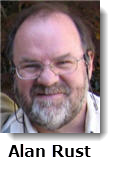|
Ted Beaudoin has been researching the Royal Air Force Ferry Command for his book "Earth Angels Rising". This decade-long project, for which research began in Jan. 2005 and ended in January 2015, has morphed into a trilogy. The months of December 1939 and January 1940 saw the start of recruiting of air and support ground crews, and administration personnel, along with the delivery of aircraft from the USA into Canada. The actual flying of bombers across the North Atlantic Ocean only began on Sunday, Nov. 10th, 1940 with a Canadian National Railroad company… the Canadian Pacific Air Service which came into being earlier, in September, 1940. It came to be known unofficially as the CPASD - or Canadian Pacific Air Services Department, a branch of the Canadian Pacific Railway - CPR . This same operation was also known by two other identifiers… ATFERO for Atlantic Ferry Organization and its Return Ferry organization/service, the RFO/RFS, for which no known logos have yet been “found” on the net, nor in corporate archives of the CPR. By April 1943 the fourth and final name change was made revealing the final “official” name of the operation, the one by which is was formally known and recognized throughout the world - the R.A.F. Transport Command. Little wonder it’s been difficult to find useful and accurate results on this incredible airborne armada by using only the words "Royal Air Force Ferry Command" or "Ferry Command". I`m trying to find out how many men and women from Canada`s commercial carriers between 1939 and 1945 may have been `seconded` to the RAF FC... your NetLetter is about the only way I can find out about this. Canada`s civilian aviation - busy lines, larger regional carriers and Canada`s CP Air in its early days and TCA among others contributed greatly to the effort and I do not think they should be overlooked. Perhaps some of you readers may have had relatives within Canada`s civil aviation community who did join, either as full-paid employees of the British Air Ministry - who funded the RAF FC, or were seconded to it by their own carrier. Ted Beaudoin, |
|
Ken Pickford sets the record straight with these comments regarding NetLetter nr 1324 - The AC DC-8 fire at YYZ was June 21, 1973, not June 22. Here's a related news item from the Montreal Gazette dated June 22, the day after the event: Click here for a photo of the same DC-8 at Vienna in August 1972, 10 months before its demise. The flight preparing for departure when the fire occurred was en route to Zurich and Vienna. CF-TIJ, FIN #822, was one of 3 DC-8-53s (Pratt & Whitney engines) acquired by AC in 1968. We refer to the photo of the model sent in by Per Christensen in NetLetter nr 1324, and received several observations - Richard Coulter had this comment - |
|
Ken Pickford also had some comments and some historical information - Re the photo of the Canadian Pacific model aircraft submitted by Per Christensen which he refers to as a "Douglas DC-4", while based on the DC-4 design it was actually a Canadair C-4 (also referred to as DC-4M) with Rolls-Royce Merlin engines, and pressurized unlike the Douglas-built DC-4. The version built under license by Canadair in Montreal was of course known by the manufacturer's "North Star" name by TCA (and the RCAF which operated an unpressurized transport version). CP didn't use the "North Star" name, referring to their four aircraft only as "Canadair C-4". BOAC, the other original customer, called theirs "Argonaut". The aircraft represented by the model, CF-CPR, "Empress of Vancouver", was unfortunately written off in a landing accident at Tokyo on February 9, 1950. Overran the runway into the water. No fatalities or serious injuries (a NetLetter some years ago had a couple of photos of the aircraft in the water at Tokyo.) The other 3 CP aircraft were sold to TCA in 1952 to join the rest of their North Star fleet. That was about the time CP's more capable and economic Douglas DC-6Bs began arriving. CP also acquired several used Douglas DC-4s from Pan American around that time. One of the ex-CP aircraft sold to TCA was the North Star lost in the mid-air collision with an RCAF Harvard trainer over Moose Jaw, Saskatchewan on April 8, 1954, killing all 35 on the North Star plus the Harvard pilot and one person in a house in Moose Jaw struck by falling wreckage. Regards, Ken |
|
and this from Bob Barwick - NetLetter Feedback - The photo of the model of the CPA DC-4 is of course the Canadian built North Star. TCA , CPA, BOAC and the RCAF operated these aircraft. My time on the North Star was on 426 Squadron, RCAF. TCA actually operated some of the RCAF North Stars until their own were delivered. BOAC called the aircraft the Argonaut. RCAF North Star 17515 is being restored at the Canadian Aviation Museum in Ottawa by “Project North Star” volunteers and member contributors. This aircraft is described on my license as a DC-4 M2. You can see the Merlin engines in the photo. RW (Bob) Barwick |
|
Jack Mills refers to NetLetter nr 1323 and 1324 Just to add to Ken Pickford's very informative e-mail on the history of the ex Wardair and Canadian Airlines A310s, I thought it might be of interest to add a few additional comments. A company that I started quite a few years ago, and that I recently retired from, had and continue to have a contract with the RCAF that provide some technical operational support for their CC 150 Aircraft (ex A 310s) that are now operated by 437 Squadron. These aircraft have been reconfigured to RCAF Specs and operate in various configurations. Some operate as tankers in the aerial refuelling configuration. The others in passenger, Cargo and VIP. They support CF 18s and other aircraft in the tanker role. They are all very active. I thought that this might be of interest to know the activities that these aircraft perform in different roles during their lifespan. Thanks Ken for your update. Sincerely, Jack M. Miles |
|
Ron Carradine sends us this memory Reading the Netletter often brings back memories, but the strangest one so far was the photos in Netletter#1324 of the DC-8 CF-TIJ (822) which caught fire during re-fuelling. Although I am not in the picture I have a weird connection to it. At that time I was on " Lav" servicing on the day shift, and sure enough the "Lav" truck trapped under the tail section was the vehicle I was assigned to. (The fire occurred on the evening shift.) Ron Carradine, (Retired) |
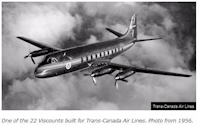
Norman Hogwood, a reader from New Zealand was checking out “Alan’s Corner” and the information in Peter Piggott's latest book and came across this photo and made the comment - One thing I, and thousands of others know, is that TCA had more than 22 Viscounts! Cheers. Norm |
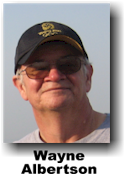 Lockheed L1011 - 500
Lockheed L1011 - 500
Although the L-1011 TriStar had been a part of the Air Canada fleet since 1973 the addition of the – 500 series in 1981 was a turning point. Fins 551 through 556 had much greater range than the TriStar at 5120 Statute Miles (8240 k.) which allowed the introduction of non-stop transcontinental service between western Canada and Europe, specifically YVR – LHR which is still a very busy route today and is now serviced by the B777 High Density configuration.
I don’t recall the specific fin# but I do remember working midnight shift in Toronto while one of L–1011–500 aircraft was modified for the return of His Holiness Pope John Paul II to the Vatican after his tour of Canada in September 1984. Sleeping quarters were installed in the J-class cabin and the maintenance check was so thorough that every wheel assembly on the aircraft was changed as a precaution.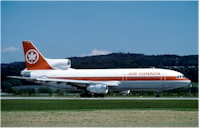
The era of service for this fleet was relatively short spanning 1981 to early 1992 when they were sold to Delta Airlines. I gathered information from Airfleets.net to track them down to their present resting places.
Fins 551, 553, & 556 remained in service with Delta until 2000 and are now stored at Victorville, California.
Fin 552 was acquired by YES Air Charter of Portugal and continued service until 2006 when it was stored and later scrapped in Lisbon.
Fin 554 was acquired by Hewa Bora Airways of the Democratic Republic of the Congo and has been stored at Kinshasa since 2007.
Fin 555 was bought by Wells Fargo Bank in 2004 but the trail ends there. It is not known if it is still operating today.
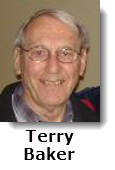 A recent article about the final flight of the Avro Vulcan brought this memory for Terry –
A recent article about the final flight of the Avro Vulcan brought this memory for Terry –
Some of the TCA offices at London Heathrow airport (LHR) were, during the '60s, located adjacent to the runway. One of the departments there was the P & S, at which I was an employee.
The 1st October, 1956, a dull and rainy one, with lowering clouds, we all heard two bangs, and wondered what they were. On looking out of the window, we saw a dark shadow pass by over the runway, and that was followed by a loud bang and a pall of black smoke started to rise. We all raced out of the office and around to the runway side of the next building and saw flames and wreckage strewn along the runway. This was the crash of the RAF Vulcan, a delta winged bomber which had just returned from an around the world demonstration flight. The two bangs were from the :Martin-Baker” seat ejection mechanism for the pilot and co-pilot of the aircraft. It seemed that the aircraft had touched down short of the runway and, in doing so, had destroyed most of the trailing ailerons thus losing control.
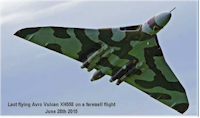 Just as we got to the scene, I looked up at a BEA aircraft which had been following the Vulcan, it had obviously been waved off and was disappearing into the low clouds. From the trajectory of the Vulcan, shown in the press the next day, after hitting the ground the aircraft rose up again and started to side slip towards our buildings before getting straight and hitting the runway. There was the usual controversy over the incident.
Just as we got to the scene, I looked up at a BEA aircraft which had been following the Vulcan, it had obviously been waved off and was disappearing into the low clouds. From the trajectory of the Vulcan, shown in the press the next day, after hitting the ground the aircraft rose up again and started to side slip towards our buildings before getting straight and hitting the runway. There was the usual controversy over the incident.
A high ranking officer, Sir Harry Broadhurst, was alleged to be at the controls - for prestige purposes - as there was an official welcoming committee awaiting the arrival of the Vulcan. Unfortunately, four civilian observers on board the aircraft perished in the crash, it seems that only the pilot and co-pilot positions are equipped with ejector seats.

